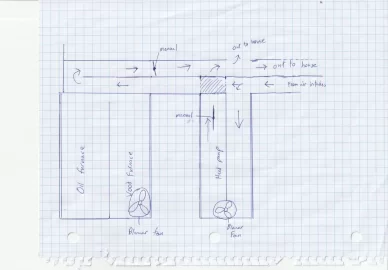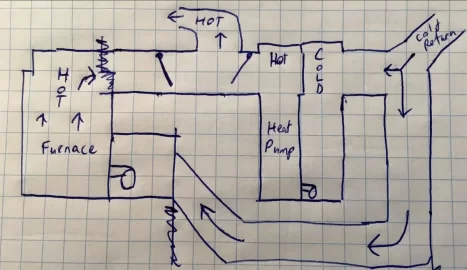Hello everyone!
I'm new to this forum and new to running a house on wood heat in general. I took a look at the forums for a while but none answer my question in particular so here goes:
We bought a house last summer that ran off a Newmac Wood/oil combination furnace. When we got our mortgage, we opted to get a ducted heatpump install into the ductwork. We live in an area fairly prone to power outages caused by storms, and so not wanting to freeze to death in case of power outages, we decided to keep the Newmac system in place and hook up the heat pump to the ductwork. The HVAC guy pulled some of his hair out rigging up the dual system, but we did end up with the setup in the picture attached (drawing is mine).
There are two manual dampers for switching over the systems: #1 at the heat pump's output duct and #2 at the furnace output duct (labelled "manual" on the picture). The hatched area is the output duct from the heat pump as it would meet the output duct from the furnace if both dampers were open. The input and output ducts are side by side in actuality, but it was easier to depict them as shown (I think).
Is it possible to run both heat pump and wood furnace concurrently? I notice that on really cold winter days where the temp is in the single digits F, the auxiliary heater in the heat pump kicks on and with it, my electric bill rises significantly. The wood furnace by itself does not seem sufficient as a sole system to heat the house (not sure if previous owner used oil in conjunction with wood or just oil) but ideally I would like to supplement the heat pump with the wood furnace at the same time, but I am worried about damaging the heatpump somehow or voiding my warranty. Can I run both systems with both dampers open or am I risking damaging something?
Grateful for any insight whatsoever since I'm a complete newbie with all of this.
Thanks,
Mike

I'm new to this forum and new to running a house on wood heat in general. I took a look at the forums for a while but none answer my question in particular so here goes:
We bought a house last summer that ran off a Newmac Wood/oil combination furnace. When we got our mortgage, we opted to get a ducted heatpump install into the ductwork. We live in an area fairly prone to power outages caused by storms, and so not wanting to freeze to death in case of power outages, we decided to keep the Newmac system in place and hook up the heat pump to the ductwork. The HVAC guy pulled some of his hair out rigging up the dual system, but we did end up with the setup in the picture attached (drawing is mine).
There are two manual dampers for switching over the systems: #1 at the heat pump's output duct and #2 at the furnace output duct (labelled "manual" on the picture). The hatched area is the output duct from the heat pump as it would meet the output duct from the furnace if both dampers were open. The input and output ducts are side by side in actuality, but it was easier to depict them as shown (I think).
Is it possible to run both heat pump and wood furnace concurrently? I notice that on really cold winter days where the temp is in the single digits F, the auxiliary heater in the heat pump kicks on and with it, my electric bill rises significantly. The wood furnace by itself does not seem sufficient as a sole system to heat the house (not sure if previous owner used oil in conjunction with wood or just oil) but ideally I would like to supplement the heat pump with the wood furnace at the same time, but I am worried about damaging the heatpump somehow or voiding my warranty. Can I run both systems with both dampers open or am I risking damaging something?
Grateful for any insight whatsoever since I'm a complete newbie with all of this.
Thanks,
Mike



